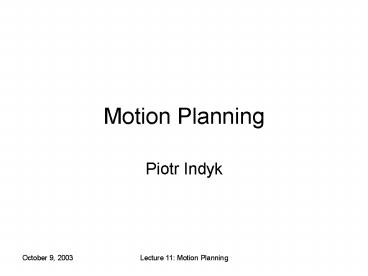Motion Planning - PowerPoint PPT Presentation
Title:
Motion Planning
Description:
Pseudo-disc pairs: O1 and O2 are in pd position, if O1-O2 and O2-O1 ... Minkowski sums are pseudo-discs. Consider convex P,Q,R, such that P and Q are disjoint. ... – PowerPoint PPT presentation
Number of Views:28
Avg rating:3.0/5.0
Title: Motion Planning
1
Motion Planning
- Piotr Indyk
2
Piano Movers Problem
- Given
- A set of obstacles
- The initial position of a robot
- The final position of a robot
- Goal find a path that
- Moves the robot from the initial to final
position - Avoids the obstacles (at all times)
3
Basic notions
- Work space the space with obstacles
- Configuration space
- The robot (position) is a point
- Forbidden space positions in which robot
collides with an obstacle - Free space the rest
- Collision-free path in the work space path in
the configuration space
4
Demo
- http//www.diku.dk/hjemmesider/studerende/palu/sta
rt.html
5
Point case
- Assume that the robot is a point
- Then the work spaceconfiguration space
- Free space the bounding box the obstacles
6
Finding a path
- Compute the trapezoidal map to represent the free
space - Place a node at the center of each trapezoid and
edge - Put the visibility edges
- Path findingBFS in the graph
7
Convex robots
- C-obstacle the set of robot positions which
overlap an obstacle - Free space the bounding box minus all
C-obstacles - How to calculate C-obstacles ?
8
Minkowski Sum
- Minkowski Sum of two sets P and Q is defined as
P?Qpq p?P, q?Q - How to compute C-obstacles using Minkowski Sums ?
9
C-obstacles
- The C-obstacle of P w.r.t. robot R is equal to
P?(-R) - Proof
- Assume robot R collides with P at position c
- I.e., consider q?(Rc) n P
- We have qc?R ? c-q?-R ? c?q(-R)
- Since q?P, we have c?P ?(-R)
- Reverse direction is similar
10
Complexity of P?Q
- Assume P,Q convex, with n (resp. m) edges
- Theorem P?Q has nm edges
- Proof sliding argument
- Algorithm follows similar argument
11
More complex obstacles
- Pseudo-disc pairs O1 and O2 are in pd position,
if O1-O2 and O2-O1 are connected - At most two proper intersections of boundaries
12
Minkowski sums are pseudo-discs
- Consider convex P,Q,R, such that P and Q are
disjoint. Then C1P?R and C2Q?R are in pd
position. - Proof
- Consider C1-C2, assume it has 2 connected
components - There are two different directions in which C1 is
more extreme than C2 - By properties of ?, direction d is more extreme
for C1 than C2 iff it is more extreme for P than
Q - Configuration impossible for convex P,Q
13
Union of pseudo-discs
- Let P1,,Pk be polygons in pd position. Then
their union has complexity P1 Pk - Proof
- Suffices to bound the number of vertices
- Each vertex either original or induced by
intersection - Charge each intersection vertex to the next
original vertex in the interior - Each vertex charged at most twice
14
Convex R? Non-convex P
- Triangulate P into T1,,Tn
- Compute R?T1,, P?Tn
- Compute their union
- Complexity R n
- Similar algorithmic complexity































